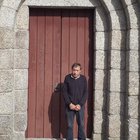Built in the 13th century, the Church of Gondar, once the seat of a small female monastic complex, is located half-way up the slope, in the valley of the river Ovelha.
Its foundation and historical route intertwine with the lineage of the Gundares, whose members achieved fame in the region throughout the Middle Ages.
Their disappearance was hastened from the extinction of the monastery in 1455. Although there are no traces of the outbuildings of the monastery, the Church of Gondar still attests to its originally monastic nature: the corbels [salient support stones] present in the outer ornaments bear witness to the existence of structures attached to the Church on both sides.
The Romanesque design of this Church was almost entirely preserved, despite the transformations it underwent throughout the Modern Age.
It falls under the category of late Romanesque, as evidenced by the quadrangular corbels and composition of the portals. The main portal has no columns, its archivolts sit on ceiling heights and the tympanum is flat.
The only element decorated in this portal is the outer archivolt, with a chequered motif, so typical of the Portuguese Romanesque.
The portal is topped by a small oculus consisting of five circles, forming a cross.
Type: Church
Classification: Public Interest Building – 1978
Route: Tâmega Valley
1202, July - King Sancho donates the tenths of Carvalho de Rei, Pedrinha, Pena Redonda and Santa Maria de Gestaçô to the Monastery of Gondar and the abbess D. Ouroana;
1202 - King Sancho donates to the Monastery of Gondar the patronage of the Church of Saint Peter of Lomba and the Church of Saint Mary of Castelo;
1258 - In the “Inquirições” [administrative enquiries] of King Afonso III, the Knights of Gondar are stated as lords of the Monastery;
1452, July 29th - D. Inês Borges is vested as the last abbess of Gondar;
1455, April 13th - By command of Archbishop D. Fernando Guerra, the Church of Gondar becomes secular;
1470 - Clergyman Pedro Afonso offers a sculpture of the Virgin to the Church of Gondar;
1548 - The Chart of the Commendation of Gondar is written;
1726 - Francisco Craesbeeck marks the Curch of Gondar as the rectory of the Commendation of Christ, with sacrarium, being, then, the rector Father Domingos Ferreira da Silva;
1758 - The Church of Gondar featured three altars, the major and the collateral, these devoted to the Holy Name of Jesus and Saint Sebastian;
1948 - According to Mário Barroca, this year marked the first appearance of the Seating Virgin, called Saint Mary of Gondar; this would be the work of Alfredo Guimarães;
1953 - Armando de Mattos draws people's attention, in an article published in the magazine Douro Litoral, to the condition of the Church of Gondar and its murals;
1978 - The Church of Gondar is listed as Building of Public Interest;
1979 - António Cardoso publishes a monograph on the Church of Gondar;
1980-1988 - Several works are carried out in the structure that rehabilitate the integrity of the building which, nevertheless, is replaced by the new church of Gondar;
2010 - Integration of the Church of Saint Mary of Gondar in the Route of the Romanesque;
2012-2013 - General conservation of the Church at the level of roofing and outer vestments; and conservation and restoration of the mural painting of the intrados of the niche on back wall of the chancel;
2014-2015 - General conservation of the Church at the level of interior vestments, woodwork ceilings and doors, and lighting and ventilation openings.
Saint Mary - 15th August
By appointment
Monument not accessible to visitors with reduced mobility.
+351 255 810 706
+351 918 116 488
visitasrr@valsousa.pt





